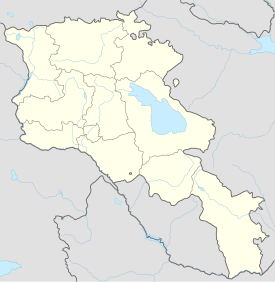Erebouni Fortress

Walls of Erebuni Fortress
|
|
| Location | Between the Nor Aresh District and Vardashen District, Yerevan, Armenia |
|---|---|
| Coordinates | 40°08′26″N 44°32′17″E / 40.1406°N 44.5381°ECoordinates: 40°08′26″N 44°32′17″E / 40.1406°N 44.5381°E |
| Type | fortified settlement |
| Height | Site sits approximately 1,017 metres (3,335 ft) above sea level. Arin Berd hill is 65 metres (215 ft) above ground level. |
| History | |
| Builder | King Argishti I |
| Material | stone (foundation/lower walls), adobe brick (upper walls), |
| Founded | 782 B.C. |
| Cultures | Kingdom of Urartu:Yervandian, Marian and Achaemenid |
| Site notes | |
| Excavation dates | Late 19th-century, 1950-1968, 2008-Present |
| Archaeologists | A. Ivanovsky (19th c.), Konstantine Hovhannisyan and Boris Piotrovsky (1950-1968) |
| Condition | Ruins; Extant foundations and lower walls, sections of the site remain to be excavated. |
| Ownership | City of Yerevan, public property |
| Management | Erebuni Historical & Archaeological Museum-Reserve; separate entry fees are required for museum and fortress |
| Public access | Yes |
| Website | Erebuni Historical & Archaeological Reserve: Erebuni |
| Active excavation | |
Erebuni Fortress (Armenian: Էրեբունի), also known as Arin Berd (Armenian: Արին Բերդ; meaning the "Fortress of Blood"), is an Urartian fortified city, located in Yerevan, Armenia. It is 1,017 metres (3,337 ft) above sea level. It was one of several fortresses built along the northern Urartian border and was one of the most important political, economic and cultural centers of the vast kingdom. The name Yerevan itself is derived from Erebuni.
On an inscription found at Karmir Blur, the verb erebu-ni is used in the sense of "to seize, pillage, steal, or kidnap" followed by a changing direct object. As an unchanging direct object, scholars have conjectured that the word may also mean "to take" or "to capture" and thus believe that the Erebuni at the time of its founding meant "capture", "conquest", or "victory."
The Circassian historian Amjad Jaimoukha gives an alternative etymology, however: eri (referring to the Èrs, the people living in the area) + buni. Buni comes from the Nakh root which spawned the Chechen word bun meaning shelter or cabin; the root however simply means lair or shelter. With its Indo-European roots "bun" initially derives from the Armenian word buyn () for "birds nest" or "lair". From Proto-Indo-European *bʰeuH-no-, from *bʰeuH- (“to be; to grow”). Cognates include Sanskrit भुवन (bhúvana, "world"), Albanian bun ("shepherd's hut") and Middle Persian بن bun ("bottom"). It may have spawned the word van in Armenian (a language with a strong Urartian substratum), albeit possibly through different roots (Urartian biani rather than Èr buni) which similarly means shelter. Interpreted in that way, the fortress would be the capital city of the Èr people. Van as a root is also present in numerous other placenames in historical Armenia, including the city Van, Lake Sevan, and Nakhichevan, so it is probable that the van in Yerevan is another direct translation of the root. Jaimoukha states furthermore that the name of the Èr also serves as the root for the Arax valley (the Erashki gorge) and for the Medieval Georgian name used in the Georgian Chronicles for Lake Sevan- "Lake Ereta".
...
Wikipedia

